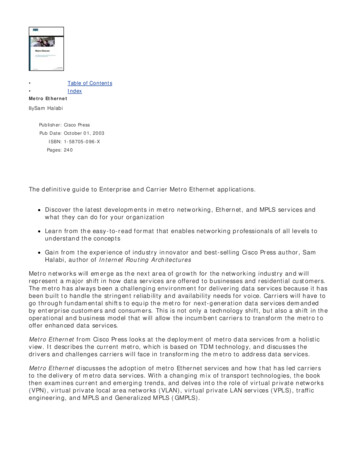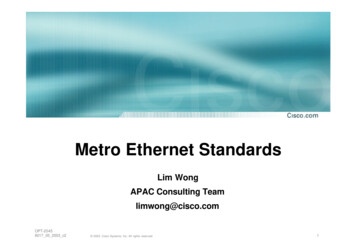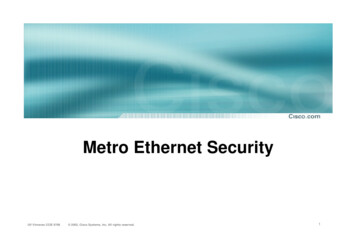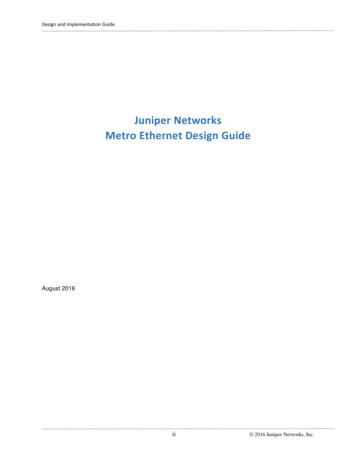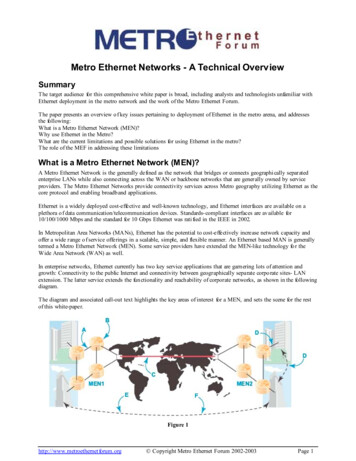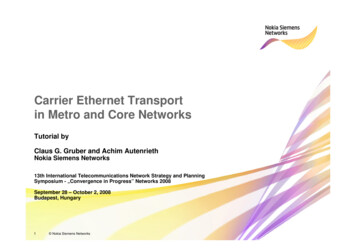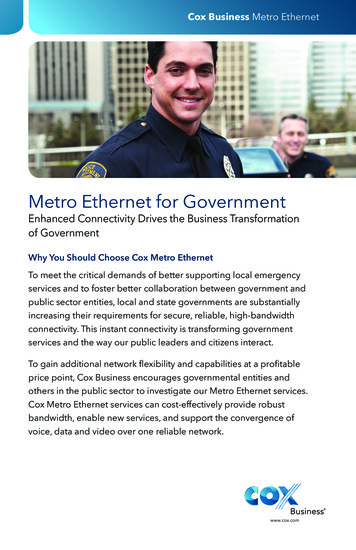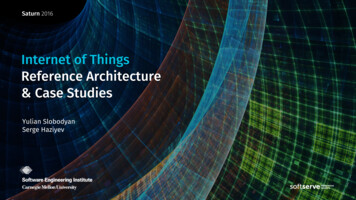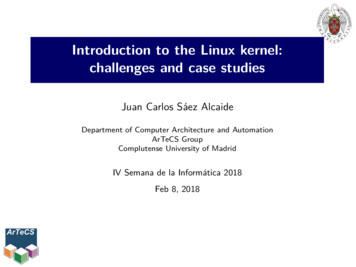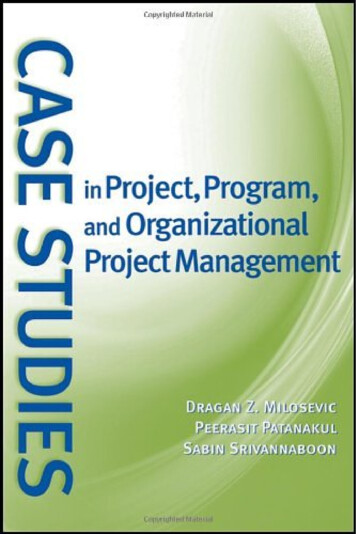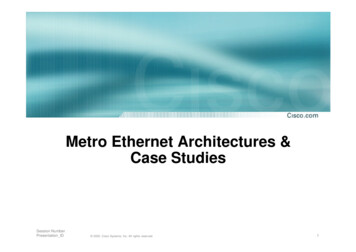
Transcription
Metro Ethernet Architectures &Case StudiesSession NumberPresentation ID 2002, Cisco Systems, Inc. All rights reserved.1
What is a Network Architecture?“The term ‘architecture’ is of great importance forsystem engineering and software development,but often defined very vague and often useddifferent.”[Leist 2002]“What is an architecture?:Objects, which are representing/defining thestructure of a System.”[Foegen/Battenfeld 2001; Bass/Kazman 1999; Bass/Clements/Kazman 1998;Clements 1999]“A network architecture is a structure or structuresof a system, which comprises networkcomponents, their externally visible propertiesand the relationship between them.”[Bass/Clements/Kazman 1998]Presentation ID 2002, Cisco Systems, Inc. All rights reserved.2
Multilayer Service PortfolioOne Architecture – Many ServicesETTBETTBEnterprise/Business:Layer 1 to 7 focussedResidential/Consumer:Layer 3 to 7 focussedETTxETTxPresentation IDLayer 1 Layer 2 Layer 3 Layer 3 Service tainmentTelephony Email MessagingMgmntScreeningManaged Services / CDNs etc IP VPNsBusiness ClassInternet AccessAlways-OnInternet AccessEthernet Layer 2 Services: P2P, MP2MP, HybridAny-to-Any Service Interworking Storage ServicesSONET/SDH services 2002, Cisco Systems, Inc. All rights reserved.Wavelength services3
A Service DrivenMetro Network ArchitectureEthernet-UNI based Services –Layer 1 - 7Network Design:Glueing Products,Features and andcloss-platformfunctions togetherServicesDefinition/SolutionDelivery of servicearchitecture:Network DesignCatalystProduct Deploymentswitching,Cisco routingCisco OpticalNetworkingSystems (ONS)ArchitectureDeploymentDeploymentaspects for services andarchitecture building blocksService Interworking;Availability; Multicast; QoS forSLA delivery; Ethernet accessrings; RedundancyPresentation ID 2002, Cisco Systems, Inc. All rights reserved.SLA DefinitionSLA ModelsSLA Definitionfocus on chitectureScalability, Cost identificationand control, Integration of transmissionand transport, end-to-end capabilitiesfor service delivery,Roles Definition4
Broadband Consumer ServicesExperience Focused – Beyond ConnectivityContent screening –Parental controlStreaming:Audio, VideoVirtual VCRVideo on iceManagementCorporateaccess:IP VPN,Voice,VideoPresentation IDEthernet UNIInternet access 2002, Cisco Systems, Inc. All rights reserved.Entertainment - GamingSecurity;VideoSurveillance5
Summary of BusinessEthernet-based ServicesAnalogous to Private Line; transparent to customer BPDUSimilar to ERS only w/ VLAN transparency; transparent to customer BPDUAnalogous to Frame Relay; opaque to customer BPDUHybrid ERS EMSTransparent LAN Service/Emulated ultipointServiceL3 MPLSVPN /InternetAccessEthernet-Based ServicesLayer 1Layer 2Point-to-PointPresentation ID 2002, Cisco Systems, Inc. All rights reserved.Layer 3Multipoint6
Business Services Delivery using MetroEthernetConnectivity Options( Service Delivery Mechanism )End UserMetro ServicesE-LineE-Lineüüüüüü(P2P)Direct Internet AccessAccess to L3 VPNVPN with Frame/Frame/ATM InterworkingVoiceVideoStorage TransportData �üüP2P – Point to PointP2MP – Point to MultipointMP2MP – Multipoint to MultipointPresentation ID 2002, Cisco Systems, Inc. All rights reserved.7
Layer 3 and Layer 2 VPN ServiceCharacteristicsLayer 3 VPNsLayer 2 VPNs SP devices forwardcustomer packets basedon Layer 3 information(e.g. IP addresses) SP devices forwardcustomer frames based onLayer 2 information(e.g. DLCI, VPI/VCI, MAC) SP is involved in customerIP routing Enterprise stays in controlof L3 policies(Routing, QoS) Support for any access orbackbone technology IP specific Foundation for L4-7Services! Example: RFC 2547bisVPNs (L3 MPLS-VPN)Presentation ID 2002, Cisco Systems, Inc. All rights reserved. Access technology isdetermined by the VPN type Multiprotocol support Example: FR—ATM—Ethernet8
Service Level Agreements:Defining the Nature of the Service Service Level Agreements define:– Attributes about a service, e.g.Availability– 99.99%, 99.999%, ?Drop– 0.01%, 0.1%?Delay– 50ms, 100ms?Jitter– 20ms, 30ms?Sequence preservation – yes, no?– Penalties if the attributes / performanceparameters are not within defined boundariesPresentation ID 2002, Cisco Systems, Inc. All rights reserved.9
The Choice of SLA will influence ServiceOfferingsQoSDeploymentDelay; JitterQoS Mechanisms,Transport choice (SONET/SDH,native Ethernet, )50ms, 100ms; 20ms?Data DeliveryRate99.99%, 99.999%?SequencePreservation 2002, Cisco Systems, Inc. All rights reserved.SecurityDeploymentRedundancy (equipment,network, protocols)Security99.99%, 99.999%?AvailabilityPresentation IDTopology &ArchitectureDeploymentYes/No?QoS Mechanisms,Transport choice,Protection types, ProtocolsQoS Mechanisms,Transport choice,10
Phase 2Phase 1Ethernet SLA ApproachesPresentation IDBandwidth Profiles - Ingress Policing onlyTwo-Rate, Three Colour Metering - trTCM (RFC 2689)Similar to common Frame Relay offerings (CIR, CBS,PIR, MBS)Phase 1 according to MEF Service Classes - Application Performance Requirementsbased SLA definition based on: Delay, jitter, loss,bandwidth/throughput, sequence-preservation, availability Service-class based SLAs – e.g. VoIP, Business latencyoptimized Similar to enhanced Frame Relay offerings 2002, Cisco Systems, Inc. All rights reserved.11
MBSCIRPIRBandwidthProfilesStep 1Ethernet Service Level AgreementsApproachesBest EffortThroughput opt.Latency opt.VoiceMAXService Classes with AttributesServiceClassesStep 2Identify Bandwidth ProfilesSimilar to Frame-Relay – PIR/CIR/MBSWell known, simple –limited traffic differentiation andper application network capacity planning Service ClassesDifferentiate and traffic-engineer accordinglyPresentation ID 2002, Cisco Systems, Inc. All rights reserved.12
The Network Architecture AbstractNetwork scale & consolidationIP/MPLS; Multi-service transport & QoS“Always on” reliabilityProgrammable servicesIntelligentIntelligentCoreCoreTransport agnosticData/Voice/ VideoVPNQoS, PEPresentation ansparency to IP, QoS, VPNsLower capitalLower provisioning costsMoreMore bandwidth;bandwidth; MoreMore appsappsServiceService Flexibility,Flexibility, QoS,QoS, SecuritySecurityIncreasedIncreased outsourcing;outsourcing; DataData andand Voice;Voice; SPSP ManagedManaged 2002, Cisco Systems, Inc. All rights reserved.ManagementManagementOSS integration,self-provisioningnetworks,service on-demand,advanced service andsupport,global presence,network diagnosticsand faultmanagement,network performance,characterization,SLA monitoring13
Metro Network ArchitectureRoles and ObjectsCoreCore DeviceDevice (P)(P)PFastFast PacketPacket Forwarding,Forwarding, SupportsSupports sophisticatedsophisticated TrafficTraffic EngineeringEngineering &&CongestionCongestion managementmanagementService-PE)*Service ApplicationApplication LayerLayer –– NetworkNetwork facingfacing PEPE (N(N-PE)*N-PEMPLS,MPLS, L2TPv3,L2TPv3, VPWS,VPWS, VPLSVPLSIPIP ServiceService ApplicationApplication layer:layer: L3VPN,L3VPN, InternetInternet AccessAccessValueValue AddedAdded Services:Services: Content,Content, ManagedManaged IDS,IDS, Firewall,Firewall, ony, L2 Service Inter-workingAggregation-AGG)Aggregation DeviceDevice (PE(PE-AGG)PE-AGGTrafficTraffic aggregationaggregation andand congestioncongestion managementmanagementEdge-PE)*Edge DeviceDevice –– UserUser facingfacing PEPE (U(U-PE)*U-PECEPresentation IDAdmissionAdmission control,control, SecuritySecurity PolicyPolicy Enforcement,Enforcement, Classification,Classification, PolicingPolicingandMarkingand MarkingMappingMapping function:function:“VPN“VPN Mapping”Mapping” toto aa VLANVLAN toto SONET/SDHSONET/SDH circuit,circuit,VLANVLAN toto EoMPLSEoMPLS tunnel,tunnel, VRFVRF litelite toto MPLSMPLS VPN,VPN, VC-IDVC-ID translationtranslationServiceService EnforcementEnforcement layer;layer; E2EE2E SLASLA monitoringmonitoring andand reportingreportingL2VPN,L2VPN, L3VPNL3VPN ServicesServices 2002, Cisco Systems, Inc. All rights reserved.* draft-ietf-ppvpn-l2-framework-03.txt 14
Metro Ethernet Network ArchitectureConnectivity Options – Behind the cloudsRelationship between layers/functionalelements and components definesProtocols, Topologies and their deploymentP ScalabilityTopology – Ring vs. Hub&SpokeN-PECost – fibre consumption, interface costs AvailabilityPE-AGGSTP convergence vs. SONET/SDH/RPRDual-Homing / RedundancyU-PE SLAsFair and secure access, consistent SLA – e2e QoSCEPresentation ID Service Ubiquity – access over anytechnology/protocol 2002, Cisco Systems, Inc. All rights reserved.15
Deployment ConsiderationsDriven by the Architecture, Services and SLAServicesSLA99.99% Service-Inter-workingwith FR/ATM/PPP TDM (E1/T1, ) Services that require- certain transporttechnology (EPL, ) Multicast VPLS/VPWS Service Interface(muxed/dedicated) End-to-End QoS Availability- Protocolconvergence- Dual-Homing/Redundancy Security deploymentArchitecture Topology & protocols MPLS deployment Installed base(Fibre and Systems) Transport & protocoloptions perfunctional elementDeployment ConsiderationsTopology InterworkingSecurity ScalabilityAvailability QoS MPLS CostPresentation ID 2002, Cisco Systems, Inc. All rights reserved.16
Architecture:Different Service & SLA models lead todifferent Network DeploymentsCost Optimized Access for ETTX:Service Bundles, Implicit SLAs,Oversubscription, RingsOptimized Access for ETTB:Wide variety of customized servicesoften including TDM, tight-SLAsE1, E3,STM1CoreLayerServiceApplication LayerAggregationLayerGbpsEthernet6SONET/SDH/RPR11 ss LayerResidential/Small Business CustomersPresentation ID 2002, Cisco Systems, Inc. All rights reserved.Customer Site ACustomer Site BEnterprise/Business Customers17
Topologies: Point-to-Point Limited scalability ifdeployed over dark-fibre # of fibres scales linearlywith # of devices # of Interfaces scaleslinearly with # devices Fibre capabilities maymake migration from2.5G to 10G challenging(attenuation, dispersionmanagement) : : CoreCore InterfaceInterface : : FibreFibreAggregation/Core : : UplinkUplink bre rarely runs point-to-point Cost of OpticsPredominates at 2.5G xWDM incurs penaltiesalsoPresentation ID 2002, Cisco Systems, Inc. All rights reserved.SiSiSiSiSiSiSiSiSiSiSiSi18
Topologies: or Ring Fibre-consumption reduced(compared to p2p fibre) Reduced # of core interfacesN:1 vs 1:1SiSiSiSiSiSiSiSiSiSiSiSi Fibre-length reduced –10G deployment feasible Rapid provisioning – provisionadditional bandwidth on thering (compared to physicallyadd fibre and interfaces)SiSiSiSiSiSiSiSiSiSiSiSi Layer 2/3 and/or Layer 1 rings?depends on traffic pattern (local vs. on-ring) and service mix – Ethernet-PL best delivered via EoS or WDM Effective and Fair use of Ring Bandwidth RPR or EoS –STP Ethernet-Rings more interesting if CAPEX is main issuePresentation ID 2002, Cisco Systems, Inc. All rights reserved.19
Rings may be deployed withdifferent technologies .Support for Multiple L1 TypesEthernet using Spanning Tree(Migrate rings with new low cost direct connections)(Inexpensive interfaces)WDM and workSTM-NSTM-NDWDM/CWDM(point to point behavior without new fiber)LocalTrafficPresentation ID 2002, Cisco Systems, Inc. All rights reserved.MetroCoreDPT/RPR(Spatial Reuse for Local Traffic)LocalTraffic20
Rings – Transport OptionsSONET/SDHMulti-service capabilityInstalled base in service providersTDM ServicesHierarchical bandwidth50 ms convergenceVery (cost-) effective for E-PLFoundation for all L1/2/3 VPNservicesDWDM/CWDMScales Fibre Capacity8Gbps, 320Gbps, 800GbpsConvergence dictated by xWDMsolutionCost effectiveEasy to deployFoundation for all Services –enables Storage etc. as wellPresentation ID 2002, Cisco Systems, Inc. All rights reserved.Switched Ethernet using Spanning TreeLower cost solutionPerceived simplicity of EthernetswitchingEasy to deploy over dark fiberFlexible BandwidthSub-second convergenceFoundation for Ethernet/IP L2/3 VPNDPT/RPRShared packet ring scales bandwidthup to 5 Gbps todaySONET/SDH framing providesinsertion point for many providersLarge number of nodes per ring50 ms convergenceFoundation for Ethernet/IP L2/3VPN21
Layer 2/3 Service InterworkingPPPFrameRelayHDLCATMEthernetEnd-to-End Service InterworkingConsistent Service Delivery / SLAPresentation ID 2002, Cisco Systems, Inc. All rights reserved. Add Ethernet toExisting ServicePortfolio ProtocolInterworking forubiquitous servicedelivery Layer 2 and Layer 3Solutions required –Solutions areprotocol specific22
Security Service-Variety / enhancedService-AttributesAttacks and DefensiveFeatures/Actionsresult in possiblynew security threats AttackDefensiveAttackDefensive Features/ActionsFeatures/ActionsLayer2/3 differentfrom simple Layer1E.g. Denial of Serviceattack can impactSLA (availability) Ethernet-centricattacksMACMAC attacksattacks(CAM(CAM tabletable overflow)overflow)PortPort SecuritySecurityARPARP attacksattacks((ArpArp spoofing,spoofing, misusemisuse ofof graciousgracious ARP)ARP)PrivatePrivate VLANs,VLANs, wire-speedwire-speed ACLs,ACLs, dynamicdynamic ARPARPinspectioninspectionVLANVLAN hopping,hopping, DTPDTP attacksattacksCarefulCareful configurationconfigurati
Metro Ethernet Network Architecture Connectivity Options – Behind the clouds U-PE PE-AGG N-PE P CE Relationship between layers/functional elements and components defines Protocols, Topologies and their deployment Scalability Topology – Ring vs. Hub&Spoke Cost – fibre consumption, interface costs Availability STP convergence vs. SONET/SDH/RPR
